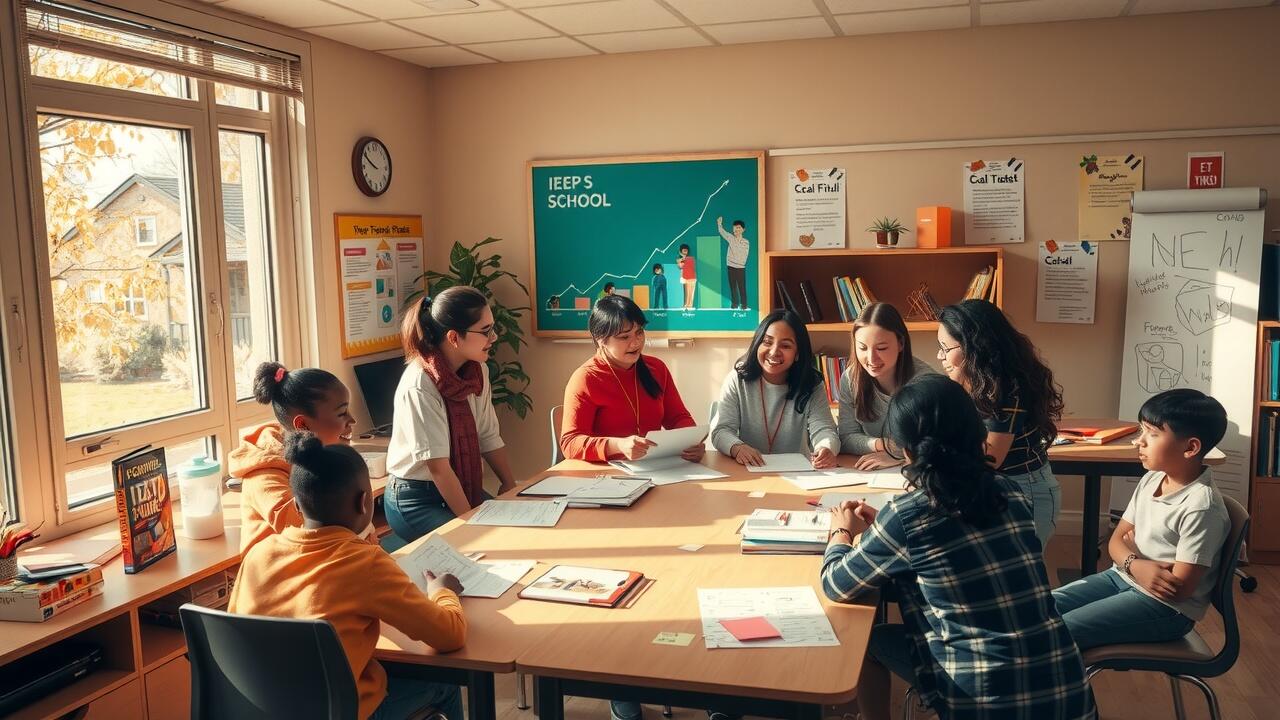Key Takeaways
- Importance of reviewing IEP objectives in November
- Comprehending IEP objectives
- Performing an evaluation of IEP objective advancement
- Procedures for reevaluating IEP objectives
- Effect of yearly IEP on November evaluations
Reassess IEP Goals In November | Importance of Reassessing IEP Goals in November
Reassessing IEP goals in November plays a crucial role in ensuring that individualized education programs (IEPs) remain effective and aligned with a student’s evolving needs. This mid-year review allows educators and parents to evaluate the progress made toward established goals, facilitating timely adjustments to strategies and interventions. Effective IEPs are not static; they must adapt as circumstances change or as new data emerges from evaluations and assessments. By focusing on the goals during this critical period, educators can identify the strengths and areas for growth in the student’s learning journey, promoting a more tailored approach to their educational experience. A thorough review in November helps set the stage for successful outcomes for the remainder of the academic year.
Reassess IEP goals in November | Timing for IEP Goal Review
The timing for reviewing IEP goals in November offers a strategic opportunity for educators and families to assess and adjust the educational plan. This period allows for a thorough examination of current IEP goal progress and provides insight into which goals may require mediation. Effective IEP goals should be flexible enough to adapt to the evolving needs of the student, making the November reassessment crucial for aligning academic objectives with the student’s ongoing growth.
Engaging in a detailed IEP goal review during this month not only helps in determining areas of success but also highlights potential adjustments for future IEP goals. By focusing on the nuances of current IEP goals, teams can ensure that each goal is relevant and achievable. The reassessment in November acts as a checkpoint for educational strategies, helping to enhance the overall quality of the IEP and ensuring that it remains aligned with the student’s development and aspirations.
Benefits of November Evaluations
November evaluations provide a crucial opportunity to reassess IEP goals in November, ensuring that the educational needs of students are met effectively. A thorough IEP re-evaluation during this month allows educators to reflect on the progress made toward strong IEP goals throughout the year. These reviews can highlight areas where students excel, as well as areas that may require additional support, leading to tailored adjustments in their learning plans.
Conducting a year IEP review in November helps maintain alignment between the student’s current performance and their educational objectives. This mid-year check-in can reveal whether the annual IEP review is still addressing the student’s needs effectively. Identifying changes early allows for timely interventions and modifications, ultimately fostering a more supportive learning environment. Schools can implement necessary changes, ensuring that the goals remain relevant and achievable for each student.
- Ensures timely identification of students’ changing needs.
- Allows for adjustments in instructional strategies as necessary.
- Promotes collaboration among educators, specialists, and families.
- Increases accountability for schools in meeting student goals.
- Enhances communication between all team members involved in the IEP.
- Helps to set realistic and achievable goals for the remainder of the academic year.
- Offers a chance to celebrate students’ successes and milestones thus far.
Understanding IEP Goals
IEP goals serve as the foundation for an individualized education program, guiding students toward their academic and functional objectives. As part of the annual IEP process, these goals undergo evaluation to measure their effectiveness and relevance. The timing to reassess IEP goals in November is critical, as it aligns with the year IEP routine, allowing for adjustments before the new IEP is finalized. Interim IEPs may be established to address immediate needs, while reflecting on the outcomes of the previous year’s IEP routinely informs future planning. This ongoing IEP evaluation not only identifies areas for improvement but also ensures that educational strategies remain aligned with the student’s evolving capabilities and aspirations.

Definition of IEP Goals
IEP goals serve as measurable objectives tailored to meet the unique needs of a student with disabilities. These goals are crucial in the IEP process, guiding educators and families in monitoring progress and fostering student development. Strong IEP planning begins with clearly defined goals, ensuring that each objective aligns with the student’s current IEP and supports their growth. During the IEP end, reviewing these goals allows for an effective reassessment of IEP goals in November, ensuring that adjustments can focus on a child’s evolving needs.
Effective IEP goals should encompass both academic and behavioral objectives, helping to create a comprehensive IEP transition plan. Regular IEP progress monitoring is essential for determining if goals are being met or if modifications are necessary. Keeping detailed IEP notes throughout the year supports the assessment process and aids in identifying areas that may need strengthening. As teams reassess IEP goals in November, they can establish a clear path forward that aligns with the student’s aspirations and benchmark achievements.
Components of Effective IEP Goals
Effective IEP goals must be specific and measurable. This clarity helps in tracking student progress during IEP meetings and ensures that the IEP team can accurately assess the appropriateness of the goals. When schools reassess IEP goals in November, these benchmarks become essential in determining if the student is on track or if adjustments need to be made. Comprehensive IEP documentation supports this process by providing the necessary data points for evaluation.
Resources available through level IEPs and interim IEP meetings play a crucial role in crafting these goals. The IEP team should collaborate closely to ensure that the goals reflect the individual needs of each student, taking into account the effectiveness of current IEP services. By conducting timely evaluations, the team can identify areas for growth and celebrate progress, ultimately enhancing the educational experience for students with special needs.
Conducting an IEP Goal Progress Review
Reassessing IEP goals in November is a critical step in the IEP process, particularly when considering the effectiveness of the current IEP program. Regular evaluations enable the IEP team to review student progress and make informed decisions during the annual IEP meeting. Data collected throughout the year, from the initial IEP meeting to subsequent assessments, provides a comprehensive view of a student’s achievements and areas needing improvement. By adhering to the IEP calendar, the team can identify any necessary adjustments to long-term and short-term goals, ensuring the student remains on track for success. This ongoing review process is vital for refining the educational strategies being implemented and ensuring that the IEP remains relevant to the student’s evolving needs.
Methods for Evaluating Goal Progress
Evaluating the progress of IEP goals requires a systematic approach. One effective method is to review the documentation prepared for the upcoming IEP eligibility meeting. This process should include analyzing data collected since the current IEP date, which provides insight into the student’s growth. Engaging the IEP case manager in discussions can also clarify specific areas to reassess. Preparing for the next IEP meeting with this data ensures that the IEP team meeting focuses on relevant progress and areas needing adjustment.
Another practical approach involves gathering feedback from various stakeholders. Input from teachers, parents, and even the student can offer a comprehensive view of goal attainment. A triennial IEP review often highlights the necessity to reassess IEP goals in November. By referencing insights from IEPs, including Individual Evaluations and Educational Services (IEEs), a clearer picture emerges regarding long-term strategies versus immediate goals. This collaborative effort is crucial for successful progress evaluation and necessary adjustments.
Identifying Areas for Improvement
Identifying specific areas for improvement is crucial when reassessing IEP goals in November. A thorough evaluation of goal progress can highlight which objectives are being met and which require adjustment. Collaborating with an IEE evaluator or agency can provide insights into student performance. These evaluations may indicate a need for new goals or updated goals tailored to better support the student’s growth in special education IEP.
Reeval planning involves careful examination of the current IEP goals to ensure they align with the student’s evolving needs. By pinpointing areas that need enhancement, educational teams can create more effective and achievable goals. This process ensures that the student receives the support necessary for continuous development, making it essential to reassess IEP goals in November to maintain educational relevance and effectiveness.
- Assess student progress regularly to identify unmet goals.
- Collaborate with educators, therapists, and parents for comprehensive feedback.
- Review assessment data and student work samples for insights into performance.
- Set measurable and attainable goals for better clarity and focus.
- Adjust teaching strategies based on current goals and student needs.
- Schedule regular check-ins to track advancements and challenges.
- Empower students by involving them in the goal-setting process.
Steps to Reassess IEP Goals
Reassessing IEP goals in November is a crucial process that allows teams to evaluate the effectiveness of the original goals and make necessary goal adjustments. This period is particularly significant for transition goals, as students prepare for critical shifts in their educational journey. As teams gather data and insights, it becomes essential to distinguish between primary and secondary goals, ensuring that all aspects of a student’s development are addressed. The reevaluation process not only informs future goal writing but also provides a comprehensive overview of student progress. By implementing targeted strategies during this reassessment, teams can better support student growth and tailor goals to meet evolving needs.
Gathering Data for Review
Collecting accurate data is crucial to effectively reassess IEP goals in November. Utilizing tools such as an IEE neuropsych eval can provide comprehensive insights into a student’s progress and needs. This information is instrumental in establishing a clear re-evaluation timeline, ensuring that the reassessment aligns with the specific reevaluation date outlined in the IEP. Gathering this data helps educational teams aim for well-informed decisions regarding necessary adjustments to goals.
Various methods can be employed to gather data for the reevaluation process, such as analyzing academic performance metrics, behavioral assessments, and observations from educators. These components offer a well-rounded view of a student’s progress towards their goals. This approach will not only facilitate a more effective reassessment but also empower educators to tailor strategies that support the student’s unique learning journey as they reassess IEP goals in November.
| Data Collection Method | Description | Frequency | Tools Used |
|---|---|---|---|
| Academic Performance Metrics | Analysis of grades, test scores, and classwork. | Quarterly | Learning Management System, Academic Reports |
| Behavioral Assessments | Evaluation of student’s behavior in various settings. | Monthly | Behavioral Observation Tools, Rating Scales |
| Teacher Observations | Feedback from teachers on student engagement and participation. | Bi-Weekly | Observation Checklists, Teacher Reports |
| Parent Input | Insights from parents regarding the student’s behavior and academic progress at home. | As needed | Surveys, Parent Meetings |
Collaborating with Educational Team
Engaging with the educational team is crucial for a comprehensive reassessment of IEP goals in November. Each member brings unique insights and expertise, creating a collaborative environment essential for addressing unmet goals. By utilizing the knowledge of teachers, specialists, and support staff, the evaluation or re-evaluation referral process can become more streamlined. Active participation fosters a shared understanding of the student’s current status and informs adjustments to the Individualized Transition Plan (ITP).
The reassessment process should prioritize effective communication among all team members. Regular meetings to discuss progress, challenges, and strategies allow for a thorough evaluation of each student’s IEP goals. Data collected from various assessments helps identify areas needing re-evaluation and supports decision-making. This collaboration ensures that all aspects of the student’s needs are met, particularly as they prepare for post-secondary settings. Regularly revisiting IEP goals in November empowers the team to make timely adjustments that align with student aspirations and capabilities.
Impact of Year IEP on November Reassessments
Reassessing IEP goals in November is crucial for aligning educational strategies with new priorities that may have emerged since the start of the school year. The timing allows for effective progress monitoring, ensuring that the goals set during the initial IEP implementation continue to be relevant and achievable. Re-assessment at this stage helps identify any necessary adjustments and informs educators and parents alike about students’ progress. Ongoing evaluations facilitate a responsive approach to possible reevaluations, giving stakeholders the opportunity to make informed decisions that enhance the overall effectiveness of the IEP. This proactive review process supports continuous progress toward meeting individual learning objectives.

Long-Term vs. Short-Term Goals
Balancing long-term and short-term goals is essential for effective IEP planning. The reassess IEP goals in November process offers a strategic opportunity to evaluate both types of objectives. Long-term goals typically set the overarching aspirations for a student’s development, while short-term goals break those aspirations into manageable timelines. Utilizing a calendar for planning ensures that educators and parents remain aligned on the progression of these goals, incorporating necessary assessments and evaluations throughout the year.
The triennial reevaluation can serve as a crucial checkpoint in understanding the progress towards long-term goals. During these evaluations, it’s important to identify areas that may require adjustments to the assessment plan. Reassessing IEP goals in November allows for a timely resolution of any obstacles faced in achieving short-term goals. This proactive approach not only fosters continuous improvement but also aligns with the overall educational objectives for the student.
Conclusion
Reassessing IEP goals in November serves as a vital checkpoint within the educational timeline for students with special needs. This period allows educators, families, and specialists to re-eval progress and adjust goals to better align with the evolving needs of the student. The emphasis on reassessing IEP goals in November underscores the importance of ensuring that supports and strategies remain effective and relevant throughout the academic year. By prioritizing this evaluation, stakeholders can foster a more responsive educational environment that promotes the success of each student.
FAQS
How do schools prepare for the annual IEP review in November?
Schools typically prepare for the annual IEP review by gathering all relevant documentation related to the individualized education programs (IEP) of each student. During this time, IEP teams will assess the progress made towards previous goals outlined in the student’s prior IEP. The review process usually involves evaluations or referrals for evaluation/re-evaluation, and decisions made by the IEP teams will take into account input from the IEE evaluator/agency. This process ensures that the goals allows teams to effectively plan for the upcoming year in the IEP process.
How should IEP teams approach the decision-making process regarding evaluation and re-evaluation referrals in November?
The IEP team should carefully assess the student’s progress and needs during the year as part of the IEP process. This includes determining if an evaluation or re-evaluation referral is necessary to ensure that the IEP needs are being met effectively. It’s important for the IEP team to collaborate and make informed decisions based on data collected throughout the year, aligning with their standard operating procedures (SOP) for reassessing IEP goals.
What steps should be taken to reassess IEP goals in November during the year?
During the year, when reassessing IEP goals in November, it’s essential that the IEP team decisions are thoroughly discussed, including the evaluation/re-evaluation referral process. This ensures that any necessary adjustments are made based on student progress and needs.
What strategies can parents use to engage in the IEP process effectively throughout the year?
Parents can take an active role in the IEP process by staying informed, attending meetings regularly, and advocating for their child’s needs throughout the year. Engaging with teachers and specialists can help ensure that the educational goals set in the IEP are continually monitored and adjusted as necessary.
What are some effective ways to support students throughout the year in the IEP process?
To effectively support students throughout the year in the IEP process, parents can engage with teachers regularly, monitor progress on IEP goals, participate in meetings, and collaborate with special education staff to ensure that the student’s needs are being met. Additionally, understanding changes in state regulations or educational practices can help parents advocate for necessary adjustments in the IEP.
How can parents actively track their child’s progress in the IEP process throughout the year?
Parents can actively track their child’s progress in the IEP process throughout the year by regularly communicating with teachers, attending scheduled meetings, and reviewing IEP goals and objectives to ensure alignment with their child’s learning needs. Engaging in feedback discussions with the IEP team can help parents stay informed and involved in the educational journey.
What are the benefits of reassessing IEP goals during the year to enhance the IEP process?
Reassessing IEP goals during the year can significantly enhance the IEP process by ensuring that the educational plan remains aligned with students’ evolving needs and progress. This ongoing evaluation allows educators and families to make informed adjustments that support students effectively throughout the year in the IEP process.
Why is it important to continually assess student progress throughout the year in the IEP process?
Continually assessing student progress throughout the year in the IEP process ensures that adjustments can be made to meet their evolving needs, enhancing the effectiveness of the IEP process for improved outcomes.
How can reassessing IEP goals in November impact the overall success of the IEP process throughout the year?
Reassessing IEP goals in November can significantly enhance the overall success of the IEP process throughout the year by ensuring that the goals remain relevant and aligned with the student’s current needs, allowing for timely adjustments and more effective support strategies.
How can family involvement influence the IEP process throughout the year?
Family involvement is crucial in the IEP process as it enhances communication and collaboration between parents and educators. By actively participating throughout the year, families can provide valuable insights into their child’s needs and progress, leading to more informed decisions that support the student’s success within the IEP process.
